It was during a hike on the trails of Mt Newton near Victoria, BC when I found it. I had wandered off the official trail, exploring the fence line of a doppler radar station when I happened to look down and spotted something black and shiny crawling over the rocks. I bent over to take a look, and was surprised to see a strange creature – 2 inches long, 62 tiny legs, 32 orange spots and 2 antennae flailing around – a small millipede: Harpaphe haydeniana
Embracing my inner child, I coaxed the little guy onto my hand and watched with bemusement as it wandered up and down my arm, antennas tap-tapping my skin as it walked. As I made my way back to the trail, I decided to keep it, and began doing some research into just what type of creature it was.
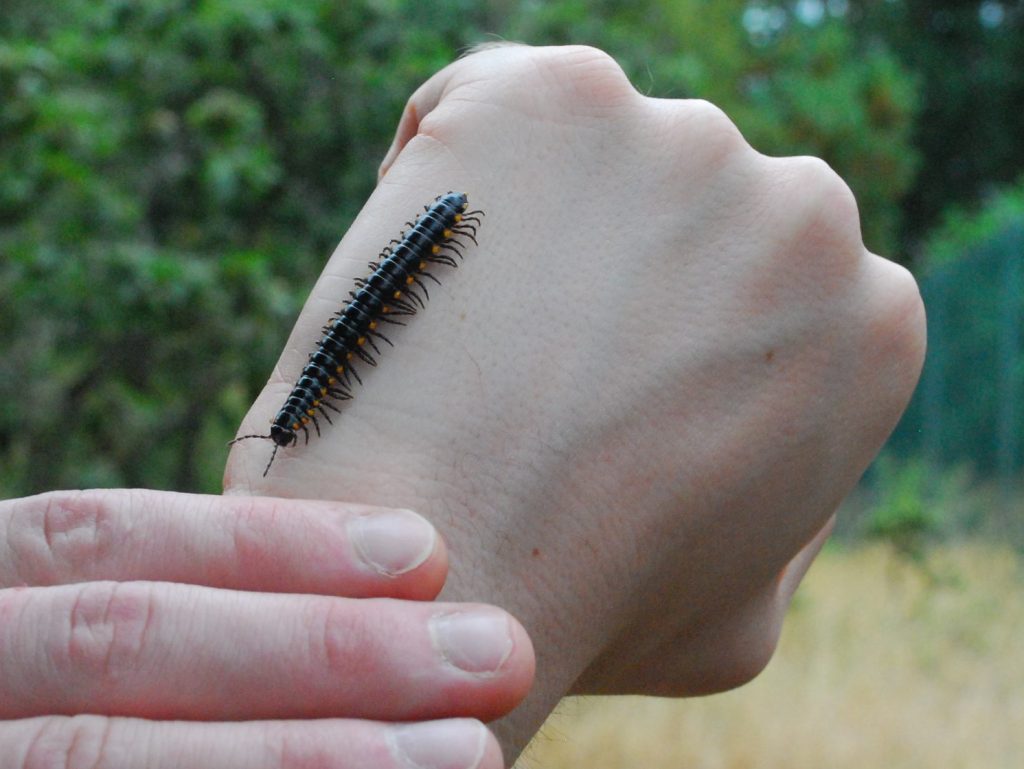
I had encountered some of these species of millipede before since they were quite common in the rain forests I explored as a child. I even tried keeping one as a pet when I was about 12, though a fall from a great height cut that experiment short. While I had seen these little guys before, I never really did a lot of research into them; this time, however, I was older and wiser and determined to learn more.
Turns out searching the Internet for “Millipede Yellow Spots BC” yielded a number of fruitful results. The scientific name for this species of millipede is Harpaphe haydeniana, though they are more commonly referred to as the ‘Yellow Spotted Millipede’ or the ‘Almond Scented Millipede.’ Harpaphe haydeniana is native to the West Coast and can be found from California in the South to Alaska in the North and they spend their existence forging on the forest floor searching for leaf litter, rotten wood and other forest debris. Like most species of millipede they are docile, and curl up into a tight little ball when threatened. Female Harpaphe haydeniana has 30 sets of legs, while the male has 31. I tried counting the pairs of legs on my new friend, and I’m pretty sure it’s 31, so I refer to it as a ‘him.’
While the species is docile and not dangerous to humans, it does have a unique defense mechanism; in addition to curling up once threatened, Harpaphe haydeniana will secrete a toxic substance, Hydrogen Cyanide, which makes them a toxic meal for birds and other small animals. As a result, Harpaphe haydeniana has only one natural predator – a species of beetle which is immune to the toxic effects of cyanide.
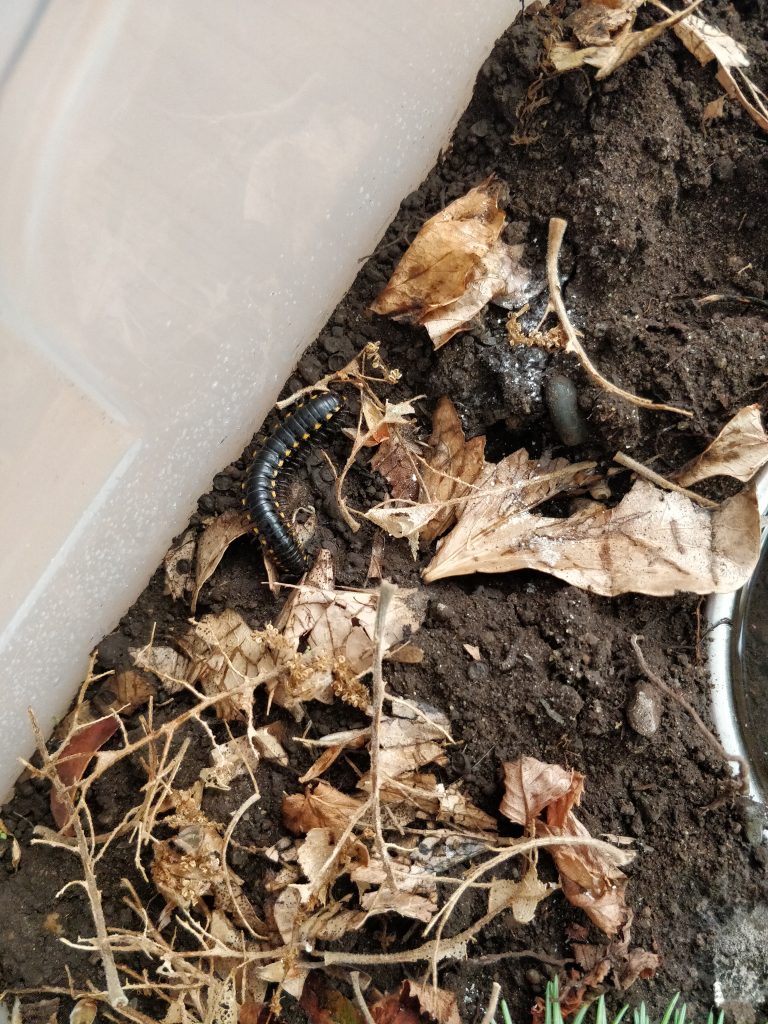
Had I known about it’s cyanide-producing capabilities I might have been more hesitant to adopt the little guy and, in hindsight, most things in nature that are brightly colored are usually toxic, however, because Harpaphe haydeniana is so small the amount of toxin produced are not dangerous to humans – unless you rub it in your eyes that is! In this case everything worked out and I managed to transport the millipede back home without causing him to curl up or feel threatened.
Once I discovered I wasn’t in mortal danger, I needed to figure out what my new pet would eat. Turns out, most things you might find on the forest floor are on the menu.
Care and Food
Harpaphe haydeniana is described as “principal shredder” in the forest ecosystem. They eat leaves and other debris that accumulate on the forest floor. Turns out this species is actually an incredibly important part of the forest ecosystem; they help to break down a whopping 30-50% of all the forest debris.
The diet of decomposing plant matter is fairly easy to satisfy. I would gather a selection of different types of rotten leaves and wood chunks and leave it up to the millipede to decide what he wanted to munch on. In terms of water, I read that millipedes generally like a moist environment, and prefer to get their hydration from the moisture in the soil. A spray bottle twice a day is the recommended way of keeping it’s habitat suitable. Including a water dish is also a good idea, since Harpaphe haydeniana will drink from standing water if it has to, but only if there is insufficient moisture in it’s environment.
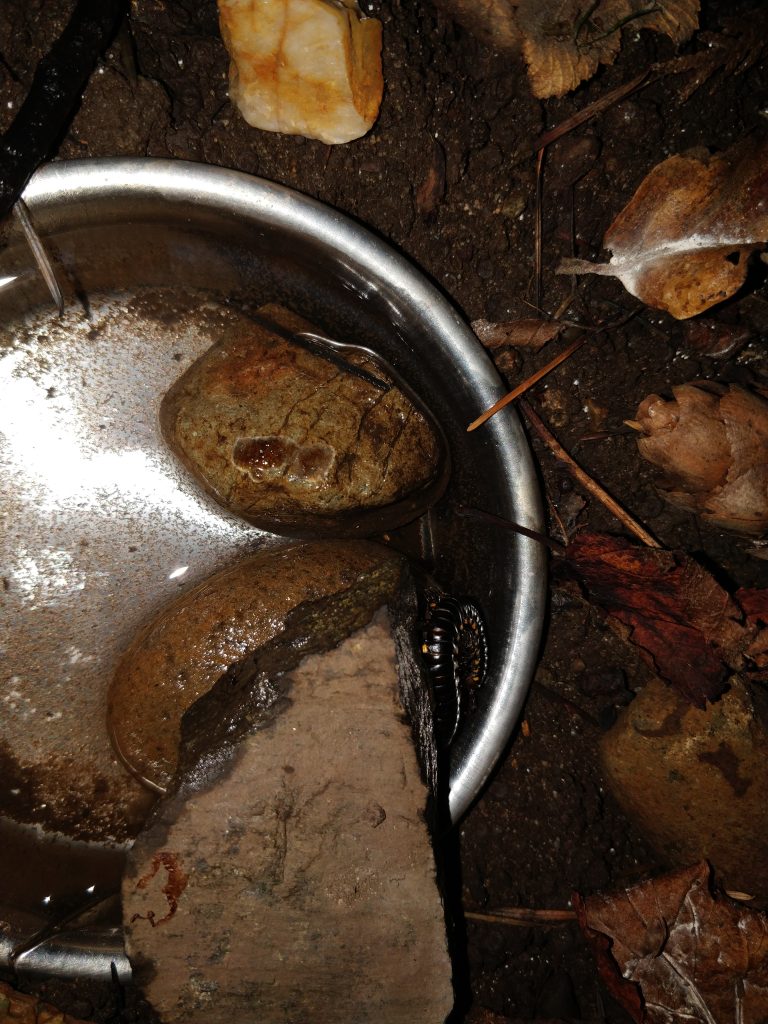
I also read that a common problem, particularly for this species of millipede, is a calcium deficiency which causes them to essentially waste away. To combat this, sprinkling some reptile calcium on it’s favorite food is a good way to ensure it’s getting enough in it’s diet. Finally, rotting wood is reportedly another good source of calcium for the little guys.
With the food problem solved, I needed to find an enclosure capable of housing my millipede. According to a number of posts online, you need to have an enclosure large enough for the millipede to be able to fully turn around it. It needs to be at least twice as wide as the millipede is long. I’m sure this advice is targeted towards other species of millipede that might be much larger, because in my case I’d end up with just a 4” wide enclosure!
A common recommendation online for housing these little critters is to use a fish tank filled with a layer of dirt. This seemed like a reasonable approach to me, so I headed down to a local pet supply store in search of a suitable aquarium. Unfortunately, it seems that suitable accommodations for the millipede were not to be had at the pet store – while they did have a few tanks they were way fancier then the simple glass box I needed. Then my roommate came up with a truly brilliant and simple solution; why not just use a Rubbermaid bin!?
The plastic Rubbermaid totes were of course more then suitable for my new little pet. I selected one about 4′ long by about 2′ wide and deep enough so that it would be impossible for the millipede to crawl out. As a bonus I managed to pick it up for under $10, which was well below my estimated fish tank budget!
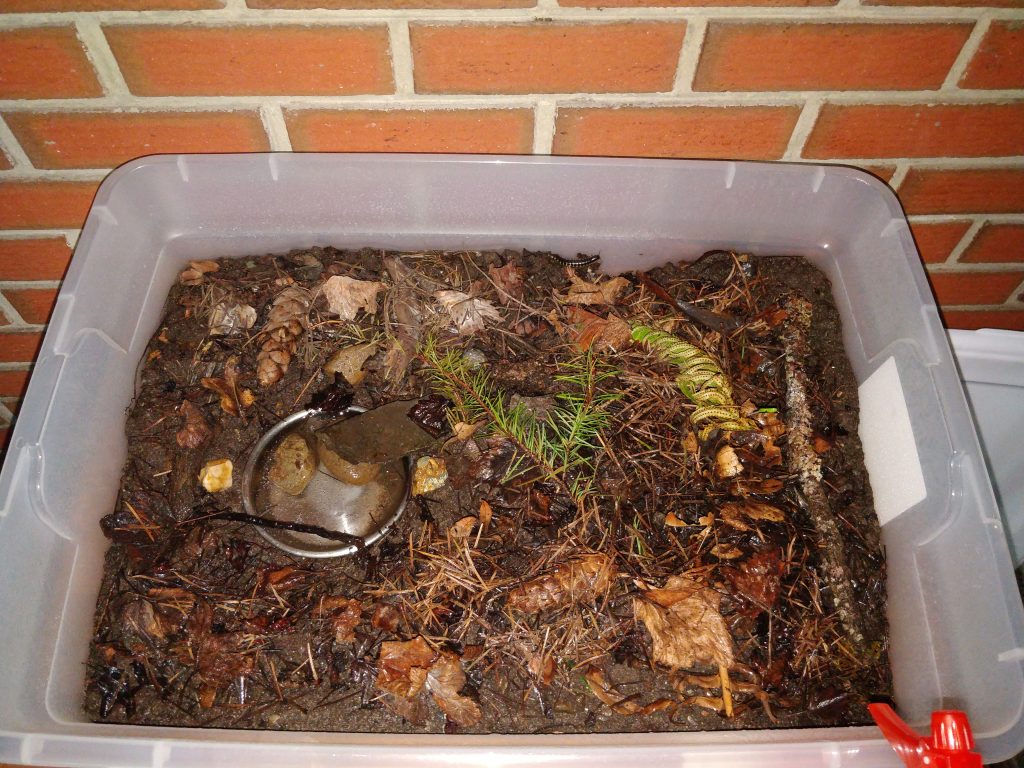
At this point my millipede had become a pet and as such it needed a name. I decided to un-originally call him ONE, because if I got another I could call it TWO and so on.
Almost Killing the Millipede
Of course, this wouldn’t be an inexperienced pet owner article without a story about almost killing the little guy, and I definitely have one of those as well. Prior to purchasing the enclosure I needed somewhere to stash ONE, as letting him crawl around on my hand while browsing pet stores was less then ideal. My interim solution was to place him with a potted plant, and then place the pot in my bathtub (after plugging the drain)! I figured the plant pot would at least give some sense of familiarity, and if he did manage to escape the pot, the smooth, steep walls of the bathtub would keep him in one spot. After double checking the drain was plugged and that ONE seemed reasonably happy I felt comfortable leaving him unattended.
Upon arriving back home I went to check on the bathtub and much to my horror I found ONE curled up and non-responsive in a puddle of water. I quickly pulled him out and stuck him on a paper towel and tried to figure out what happened. As best as I could determine, he managed to crawl out of the plant pot but fell into a large puddle of water form which he was unable to escape. I cursed my stupidity and figured this was the end of the road for my little pet and left the bathroom to contemplate my poor choices. A while later I returned to clean up the bathtub, and imagine my surprise when I spied my millipede happily crawling around the perimeter as though nothing had happened! Serendipity for sure! I’m still not entirely sure what transpired, as best I can tell when he fell into the water ONE went into some kind of defensive mode and after deciding the ‘coast was clear’ he returned to exploring his new environment. Turns out these little guys are a little more sturdy then I originally thought.
Since I once again had a living millipede, I proceeded to set-up the enclosure on top of an old TV stand, filling the tote with soil and leaves from the garden and adding in a small bowl of water. I was also sure to add some rocks into the water bowl which would allow ONE to climb out should he find himself falling into the water.
Daily Life with the Millipede
Caring for Harpaphe haydeniana is fairly straightforward. I needed to ensure he had a steady supply of rotting leaves which would be used to line the bottom of the tote and would form the substrate on which the millipede lives and eats. The key here is to ensure that this substrate is composed of rotting material, as they won’t eat fresh leaves. I also needed to periodically sprinkle some powdered calcium around the enclosure, in particular ensuring that the leaf litter and anything else that could be considered food received a healthy dusting. Side note, using a salt shaker does NOT work well for dusting powered calcium, it ends up in a single clump. Using the end of a zap strap worked much better.
The other thing Harpaphe haydeniana really likes is moisture. As I explained above, using a spray bottle is the recommended way of introducing sufficient moisture into their artificial habitats. I started off by giving ONE a couple of squeezes of the spray bottle in the morning and the evening, then I spied him drinking from the water bowel one day, so I got much more aggressive with the daily spraying. Never saw him use the standing water again so I figured it must have been enough.
Once I figured out what ONE needed in terms of care, I got into a routine of checking the enclosure in the morning and giving it a spray as I left for work, checking and spraying when I arrived home, and giving it a final check before turning in for the night. Over the months, I got to know the little guy and and his idiosyncrasies.
- He prefers to walk the edges of the enclosure. Most of the time when I spied ONE walking around it was along the edges of the enclosure. With one antenna tapping the ground in front of him and one antenna tapping the side he would go round and round, often in a clockwise direction. I found myself wondering if he had any concept of being inside a box, or if it was all new terrain to him.
- He doesn’t like getting sprayed! While millipedes like to live in a moist environment, this one at least didn’t like coming in direct contact with the spray bottle. The couple of times I did accidentally spray water on him, ONE would make a beeline for the nearest rock or leaf and hide. I tried to do him the courtesy of not spraying water directly on him after that.
- He didn’t seem to mind crawling over my hands. While I was always careful not not pick ONE up, least he should feel threatened and excrete cyanide onto me, I was able to coerce him to crawl into my hand and would take him out of the enclosure for explores of my desk and office floor. He never seemed bothered by the abrupt change in scenery.
- Sometimes he would disappear for a while. On more then one occasion I would go several days to a week without seeing my little pet. It would get to the point where I found myself wondering if he was still alive, then all of a sudden he would appear again, crawling the perimeter of the enclosure in a clockwise direction. I still wonder what he did on those days that he would go missing.
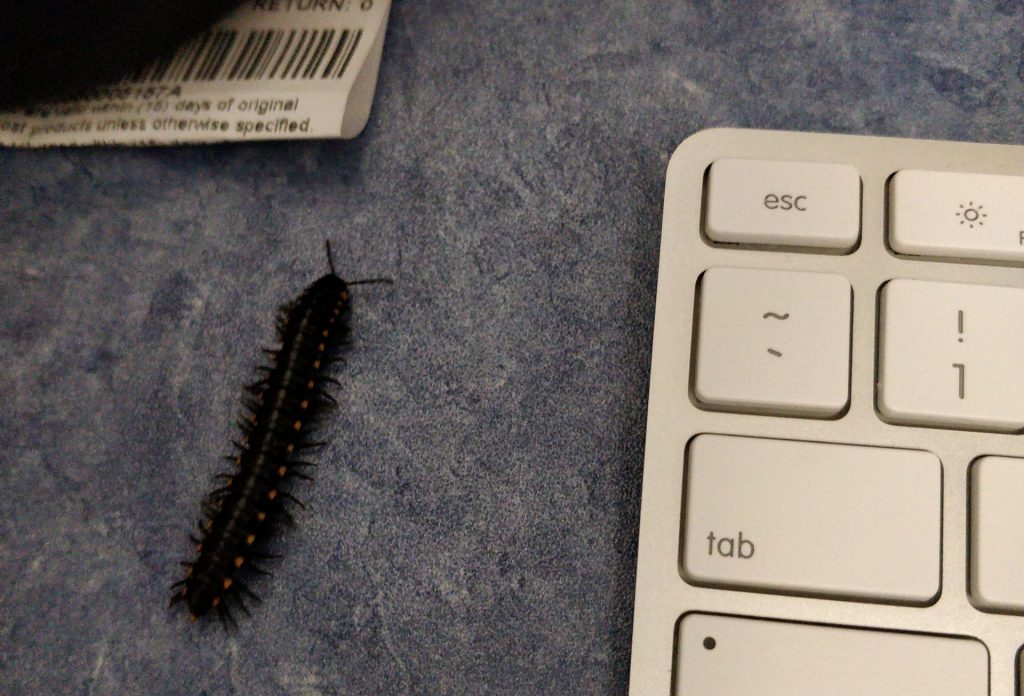
Overall, ONE was a pretty active little guy and I was impressed with how entertaining he became. Reading some accounts online of how millipedes would burrow into their substrate and rarely be seen, I’m happy my little guy was so visible, and so willing to be handled.
Nothing Lasts Forever
Harpaphe haydeniana are supposed to live for around 2 years, and sure enough around March of 2022 I began to notice ONE really starting to slow down. He would still crawl around his enclosure, but with nowhere near the gusto that he had in previous months. Then, one day in April I found him curled up in a corner and he never moved again.
The timeline seems about right; when I found him, ONE was fully grown, and if I assume he was born in the spring he was already likely over a year old, so the April timeline made sense for a death of old age. Despite that fact that his death was not unexpected and despite the fact that he was far from a life-altering pet I couldn’t help but feel a twang of sadness upon his death, I had grown quite attached to the little guy, even though he was just a millipede.
Overall, my experience with ONE was a positive one, and the millipede turned out to be just enough pet for me. While a dog or cat requires a lot of care, my millipede was very low maintenance. As long as I kept him watered and fed the little guy was happy to do his thing, oblivious to anything going on around him.